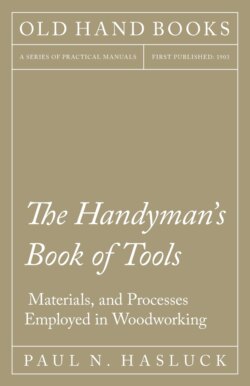Читать книгу The Handyman's Book of Tools, Materials, and Processes Employed in Woodworking - Paul N. Hasluck - Страница 107
На сайте Литреса книга снята с продажи.
OTHER POINTS IN SAW SELECTION.
ОглавлениеAnother very important point to be noticed when purchasing a hand saw is to see that after its blade has been fully bent it springs back perfectly straight. A soft saw will not, as a rule, spring back like this, nor will a saw of uneven temper. A serious defect in some saws should here be mentioned. Very often one or more silvery-grey spots may be seen in the saw plate, generally at the tooth edge. Such a spot indicates a hard or, as it is often termed, a rash place. In setting the teeth they will often break at these places, and sometimes a piece of the plate breaks out. Should a piece break out halfway between the heel and point, the saw becomes useless until the teeth are recut; and to recut with a file requires some practice. It will be wise, therefore, when choosing a hand saw to select one free from such blemishes. In selecting a saw, for whatever purpose, do not be tempted by a low first cost, as this is no criterion as to its ultimate cheapness. What is required is a blade made of the very best quality of steel, combining, as far as may be, flexibility and toughness with a sufficient degree of hardness to allow of the steel carrying a good cutting edge. A saw bearing the name of a maker of repute should, and usually does, give satisfaction. The handle should be comfortable to the grasp and made out of thoroughly seasoned wood. Beech handles, with countersunk rivets, are preferred by many. A thin and narrow saw is preferable to a thick and wide one, but care must be taken, however, not to select too thin a blade, and that the saw is stiff in work, as, should it buckle, it may give a great deal of trouble. If the saw has been hammer-set—in contradistinction to spring-set—without fracture to the teeth, it is a very fair test as to the quality of the steel. The blade should ring clearly when struck with the finger, and when sprung over by hand it should not jar in the handle. Finally, if possible, try the saw on a piece of difficult cutting wood, and see how it behaves: if it cuts fast and clean with a moderate expenditure of power, it is what is required. Increment teeth have of late come more into use—that is, the point of the saw is arranged with finer teeth than the heel—and are liked by many workers, as the fine teeth begin the cut smoothly, and the coarse teeth prevent the saw clogging.
Fig. 310.—Hammer for Setting Large Saws.
Fig. 311.—Large Setting Iron.
